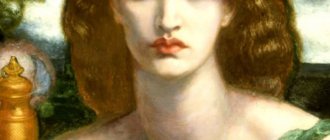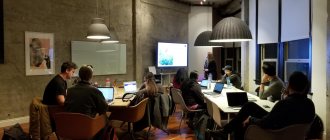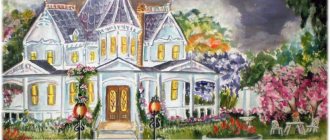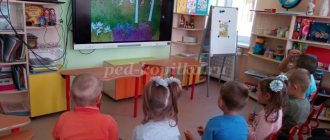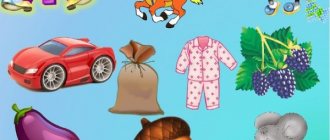"Autumn" No. 1
Read poems to your child and discuss them. (Memorize a poem of your choice.)
Autumn The leaves are falling, falling - leaf fall in our garden. Yellow and red leaves curl and fly in the wind. Birds fly south - geese, rooks, cranes. Now the last flock is flapping its wings in the distance.
Autumn Autumn plays with the leaves, picks leaves from the branches. Yellow leaves fly straight into the children’s hands.
Gifts of Autumn Autumn walks in our park, autumn gives gifts to everyone: Red beads - for rowan, pink apron - for aspen, Yellow umbrella - for poplars, autumn gives us fruits.
Question. To whom does autumn give what?
MAGAZINE Preschooler.RF
A series of finger games in mnemonic tables. Lexical theme “Autumn”This series of finger games is intended to help preschool teachers. Here are examples of finger gymnast mnemonics for preschool children.
A series of finger games in mnemonic tables.
Why in mnemonic tables?
Mnemonics is a system of methods and techniques that ensure effective memorization, storage and reproduction of information.
The role of mnemonic means in improving memory is that “by turning to the use of auxiliary means, we thereby change the fundamental structure of our act of memorization; previously direct, immediate memorization becomes mediated.”
The use of mnemonics for preschoolers with disabilities is becoming increasingly relevant.
Mnemonics technology allows you to develop the general abilities of children with disabilities without mental and psychophysical overload, i.e. adapt them to the future educational process, as well as teach them to use rational methods of information processing, select an individual “key” for memorizing and processing information for each child, taking into account individual features of thinking.
Finger gymnastics for a child with disabilities will be as difficult and difficult to memorize as a simple poem, although the text of finger gymnastics is actively accompanied by finger movements. Therefore, looking at the mnemonic table of finger gymnastics, children with disabilities become more confident, actively interact with the teacher, telling the text of finger gymnastics, because there is always a “hint” in front of them, and they also actively learn to bend their fingers according to the text, or roll springs from “SUJOK” (the finger gymnastics “Mushrooms” can be performed by massaging the fingers with these springs, and the fat, pot-bellied man evokes many positive emotions in children).
It is important that in addition to the communicative function, the planning function of speech develops. The child learns to construct his or her statements consistently and logically. Children are shown a mnemonic table and the encoded information is deciphered. Logical connections (“hooks”), quantitative and qualitative characteristics are established. Thus, the entire mnemonic table is memorized.
For children with disabilities, you can use easier tables, the main thing is that the pictures are related to each other, since in order to memorize the tables, children must either write a story, or connect them in meaning, or classify them.
Thus, the use of mnemonic techniques in correctional and developmental education helps preschoolers with disabilities:
- develop and use all types of memory (auditory, visual, tactile, motor, long-term);
- develop logical thinking;
- develop imagination;
- develop orientation in space and on a plane;
- develop hand motor skills.
Finger gymnastics N. Nishchev
"AUTUMN LEAVES"
One, two, three, four, five, We will collect leaves, birch leaves, rowan leaves,
We will collect poplar leaves, aspen leaves, oak leaves, and take an autumn bouquet to Mom.
Finger gymnastics “Autumn leaves are quietly spinning”
The autumn leaves are quietly spinning, The leaves are smoothly falling under our feet And rustling and rustling under our feet, As if they want to spin again.
Finger gymnastics “Autumn”
The winds shake the apple trees. Leaves fly off the branches. Leaves are falling in the garden, I rake them.
Finger gymnastics “Mushrooms”
(bend your fingers one by one)
This finger went into the forest, This finger found a mushroom, This finger cleaned a mushroom, This finger fried a mushroom,
This finger sat down and ate it, and that’s why it got fat.
| Next > |
Lesson topic: Autumn. Signs of autumn.
Age:
7-9 years
Conclusion:
ZPR of cerebral-organic origin.
Form
of lesson:
individual lesson
Type of lesson:
correction and systematization of knowledge
Topic of lesson:
Autumn. Signs of autumn.
Objectives:
1. Educational:
To consolidate the ability to observe seasonal changes in nature, knowledge of the names of the autumn months and the characteristic signs of autumn.
2.Developing:
Development of elementary mathematical concepts.
Development of coherent oral speech, development of the child’s fine motor skills. 3. Educational:
To cultivate the ability to understand and appreciate the beauty of our native nature.
Arouse interest in self-improvement, self-development, instill interest in classes. 4. Correctional:
Correction of higher mental functions (attention, memory, thinking); adjust and develop spatial concepts;
Methods:
verbal, visual, practical.
Equipment:
illustrative material on the topic, mood emoticons, temporary presentation board.
Progress of the lesson:
I. _ Organizational stage.
-Hello!!!
What's your mood now? Choose from the suggested images to suit your mood. (MOOD SMILES) II. Updating knowledge. Work on the topic.
- Development of temporal representations.
The defectologist reads a poem:
Leaves from trees in the forest are falling off.
The rain is pattering sadly on the roofs.
The bright sky says goodbye to the earth
Gloomy autumn is knocking on the window.
- What time of year do you think the poem is talking about?
- Name the autumn months?
- What can autumn be called in September? (early, golden).
— What can you call autumn in October? (rainy).
— What can you call autumn in November? (late).
- Introductory conversation
– What can you say about the sun in autumn?
(It doesn’t heat well, there are fewer sunny days).
—What is the sky like in autumn? (Gloomy, heavy, cloudy, rainy, cloudy, gray, dark).
— What happens to the trees in the fall? (Leaves: turn yellow, turn red, fall off, dry out. The trees stand bare.)
— What is the name of the phenomenon in nature when leaves fall from trees? (Leaf fall).
— Leaves in autumn, what do they do? (They turn yellow, turn red, dry up, fall, spin, fly, crumble)
— What happens to the grass in the fall? (Dries up, turns yellow, fades)
— What do birds do in the fall? (They fly away to warmer climes)
- Why? What are these birds called? (Migratory)
— What do insects do in the fall? (They hide in old stumps, snags, climb under the bark of trees).
— What do animals do in the fall? (They are preparing for winter. Some go to bed for the whole winter - a bear, a hedgehog, a badger. Others change their skin - a hare, a squirrel, a fox. Still others make supplies for the winter - a squirrel, a hedgehog.)
— What is the weather like in autumn? (Cold, rainy, windy, sometimes snowing.)
- What happens only in autumn? (Harvest, birds flying away, leaves falling.)
III. Development of fine motor skills. Finger gymnastics. Autumn scattered leaves (make wave-like movements with palms) Decorated them with a brush. (make smooth waves with their palms up and down) We will go into the autumn forest, (“walk” with the fingers of both hands) We will collect leaves into bouquets. (they cross their palms with their fingers spread out) A maple leaf, an aspen leaf, (they bend their fingers one by one, starting with the thumb, on both hands at the same time to the name of each leaf) An oak leaf, a mountain ash leaf, a red poplar leaf and jumped down onto the path. (clap hands loudly) IV. Development of hand-eye coordination.
- "Find according to the diagram"
Goal: development of spatial thinking and perception. A drawing is placed in front of the child, which shows a diagram of the path he must take to get to the goal. V. Correction of higher mental functions.
- Game "Pick the sign"
. Children select signs for the word “autumn” using mnemonic pictures.
Autumn (what?) - ... (Cold, rainy, golden, colorful, colorful, fruitful, warm, cloudy, clear, snowy, cheerful, sad, deciduous, etc.)
- The game “What doesn’t happen in autumn?”
Snowdrops do not grow in autumn.
In autumn they don’t swim in the river.
They don't sunbathe in autumn.
In autumn they don't wear fur coats.
VI. Development of elementary mathematical concepts.
- "Right left"
Goal: automation of concepts from right to left
Pictures or postcards depicting several children or animals. The child is asked to answer the question: “Who is sitting to the right of the bear? Name everyone who sits to the left of the bunny,” etc. The same exercise can be done with toys or any objects, placing them on the table.
VII. Development of coherent oral speech. Consolidation of knowledge. “Expand and tell” Goal: Establishing cause-and-effect relationships, developing coherent speech. The student receives a series of pictures on the topic of the lesson. His task is to select picture-episodes in the right order and convey the content of each, thus composing a whole story. VIII. Results of the lesson. Reflection. -What did you and I do today? - Well done, we did a great job today. — Name your associations.
Handing out homework.
SPEECH DEVELOPMENT. LEXICAL TOPIC “GIFTS OF AUTUMN”
CHILDREN SHOULD KNOW NOUNS: carrots, tomatoes, cucumbers, cabbage, beets, turnips, onions, radishes, garlic, radishes, lettuce, sorrel, parsley, peas, potatoes, bed, shovel, rake, watering can, harvest, vegetable garden, vegetables, vinaigrette , cabbage soup, borscht, zucchini, pumpkin, seeds, seedlings, peel, pod, cabbage, vegetable storage, apple, pear, plum, cherry, lemon, orange, tangerine, apricot, grapes, cherry, banana, pineapple, peach, garden, fruit , basket, apple tree, seed, root, fruit.
ADJECTIVES: green, red, juicy, hard, crispy, soft, ripe, oval, round, bitter, sweet, tasty, aromatic, salty, pickled, pickled, fresh, ripe, sour, healthy.
VERBS: water, grow, care, prepare, salt, cook, stew, fry, wipe, wash, cut, chop, clean, plant, weed, clean, pluck, collect, pull, cut, pluck, ripen, ripen.
CHILDREN SHOULD BE ABLE TO: Identify an extra object and explain why? Apple, pear, potato, lemon. Carrots, cabbage, peas, plums.
SELECT SIGNS: Cucumber (which one?) - green, long, crispy... Turnip (which one?) - yellow, round, hard... Apple (which one?) - round, ruddy, sweet, healthy...
Carrots (beets, turnips, cabbage) - (what kind?) - tasty, crispy, orange, large, round, healthy, juicy, large, small…. Onion (cucumber, tomato, garlic, zucchini) - (which?) - tasty, crispy, red, large, round, healthy, juicy, large, small, bitter... Pear (plum) - (which?) - tasty, healthy, soft, green, oval, sweet, juicy, large, small…. Banana (lemon, peach, orange) - (which one?) - tasty, sour, yellow, large, round, healthy, juicy, large, small….
GAME "GUESS WHAT FRUIT I'M TALKING ABOUT?" Tasty, healthy, soft, green, sweet, juicy appetizing...(pear) Sour, yellow, oval, healthy, juicy...(lemon) Juicy, sweet, ripe, hard, red... (apple) Delicious, yellow, soft, long... (banana) Delicious, healthy, soft, blue, oval, sweet, juicy, small...(plum) Delicious, orange, round, healthy, juicy, large...(orange)
FORM RELATIVE ADJECTIVES: Apple juice - apple; Apple puree - apple; The filling for apple pie is apple.
WHAT GAME? WHICH? WHICH? »What kind of jam? What kind of puree? What kind of jam? What kind of juice? What kind of compote? What kind of compote? What drink? What fruit drink?
GAME “GUESS I WANT JUICE OR JAM?” I want apple... I want apple... I want pear... I want pear... I want apricot... I want apricot... I want orange... I want peach... I want plum... I want banana...
GAME “WHAT SHALL WE COOK?” From lemon - lemon juice. From banana - banana puree. From an apple - apple jam. From pears - pear compote (orange, peach, plum). From fruits - fruit salad. From carrots - carrot juice. From cabbage - cabbage juice. From beets - beet juice. From cucumbers - cucumber salad. From potatoes - potato soup. From peas - pea soup.
COMPLETE DESCRIPTIVE STORIES ABOUT VEGETABLES AND FRUITS: Title. Where does it grow? Appearance. What does it taste like? What is made from it?
COMPARE: Apple and lemon; cucumber and tomato...
VEGETABLES are fruits grown by humans. They grow in the garden. Some vegetables grow in the ground - beets, garlic, potatoes. Other vegetables grow on the ground - tomatoes, zucchini, cucumbers. Vegetables are very healthy, they contain a lot of vitamins and other substances. Salads, soups, side dishes and other dishes are prepared from vegetables.
FRUIT is fruit grown by man. They grow in the garden on trees. Fruit trees are looked after: the soil is loosened, fertilized, watered, and the trees are sprayed against pests. A fruit tree has a trunk, branches, leaves, fruits and roots. Fruits are very healthy, they contain a lot of vitamins and other substances. Fruits are used to make jam, jam, juice, compote, baby food - puree.
GAME “MAKE A PROPOSAL”.
Children must complete the sentence and then repeat it in full.
The tomato is round, and the carrot... The cucumber is oval, and the pumpkin... The onion is bitter, and the carrot... The cucumber is green, and the beet... The radish is small, and the radish... The zucchini is large, and the pumpkin... The tomato is sour, and the garlic... The carrot is in the ground, and the tomato...
